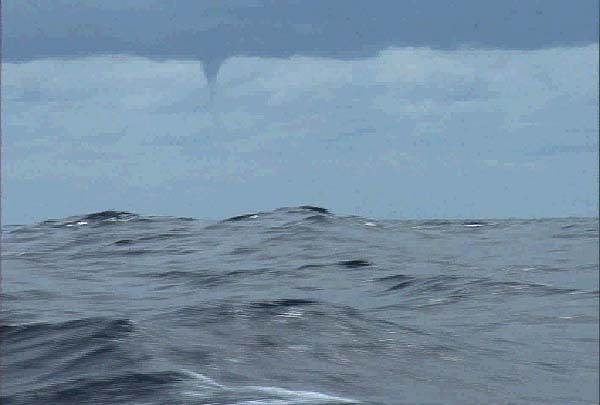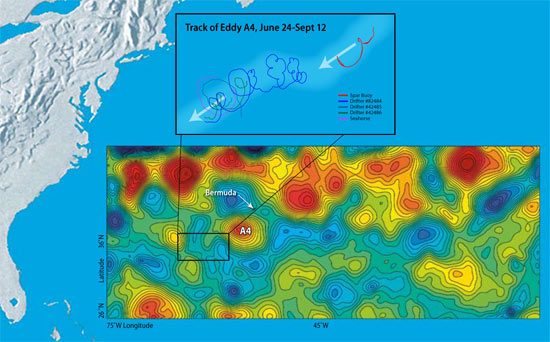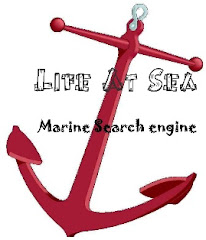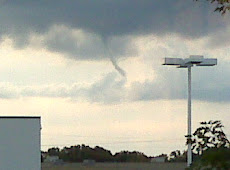 Undersea Weather
Undersea WeatherThe extreme weather that impacts us is now having an effect where you might least expect it - deep under the sea. As this ScienCentral News video explains, scientists have linked climate change to population booms and busts in deep-sea life.
Not-So-Sunny Underwater Forecast
Warm waters might be soothing in a bathtub or a swimming pool but when the ocean heats up it can get mighty uncomfortable, and even deadly, not only for the animals who live there but for land lovers too. Peruvian and Ecuadorean fishermen even coined a term for the warm water phenomenon in the late 1800s, El Niño, their nickname for unusual Christmastime changes in water temperature that impacted their catch; El Niño has since been shown to cause extreme weather conditions like hurricanes and droughts.
Now scientists say that El Niño and La Niña - when ocean temperature in the Equatorial Pacific grows colder than normal compared to El Niño - are not only impacting life on land and on the sea surface, but also life on the ocean floor. Deep-sea ecologist Henry Ruhl, working with colleagues at Scripps Institution of Oceanography, reported in the journal Science that changes in surface ocean climate may be impacting animal populations far under the ocean"The sea life populations were changing in a way that suggested that climate was linked to food supply, and food supply was linked to the abundance of the animals in the seafloor on time scales that were roughly similar to what we were finding in above-water systems," Ruhl explains. "So it seems plausible that climate could be affecting the deep sea relatively rapidly, and wasn't somehow far removed in time, even though it's out of sight, out of mind to many people." But he's quick to add that more research is needed to find the specific causes of the population jumps or declines he reported.
At "Station M," 130 miles off the California Coast, the Scripps team has been studying an abyss 13,400-feet deep since 1989. They set out to document something many agree they know little about - what happens deep beneath the sea. Using a submersible camera-mounted sled that snapped photos of ocean life every five seconds, researchers tracked ten mobile animal populations, including starfish and sea cucumbers. They took ocean floor samples of nutrient-packed sludge called sediment, a mix of feces and dead phytoplankton, amongst other things, that sinks from the sea surface and provides food to animals on the seafloor. Then, the team compared sediment composition to changes in time and weather.
The information gave Ruhl a more complete picture of how deep-sea marine animals may be impacted by climate change. "We believe that food supply is one of the only plausible mechanisms for the climate to be affecting the animals on the seafloor," he says. "And we believe it's happening through a mechanism in which climate affects the productivity or the amount of sea life above the study site on the overlying surface waters."
 |
| Satelite imaging of climate changes and ocean temperatures produced by El Nino. image: NOAA |
Experts say scientists are getting better at spotting El Niño events ahead of time, even though solutions to the problem, and the subsequent impact it has on sea life, aren't so forthcoming. The National Oceanographic and Atmospheric Administration (NOAA) is one agency that tracks El Niño. Scientists there were able to predict the 1997-1998 El Niño six months ahead of its arrival, using instrumentation like satellites and ocean buoy data. Their predictions saved California over a billion dollars since the state was able to prepare for the event ahead of time.
So, should we be putting the sea cucumber up there with other endangered species? Not yet. Ruhl says that what we do with the information uncovered in the study is "really a values question...not in our lifetime will we be affected by what happens in the deep sea, other than knowing that it's happening."
It's in a hundred years or more that people will have to fish for solutions to much bigger problems down below.
MARITIME NOTES
IMO – International Ice Patrol
The IMO issued a circular forwarding a communication from the Government of the United States concerning International Ice Patrol (IIP) services for 2008. SN.1/Circ.268 (1/22/08).
ON THIS DAY IN HISTORY - THE PRINCESS VICTORIA DISASTER
"1953, Irish Sea: 130 die in ferry disaster. The inquiry concluded the ferry owners were to blame for the poor design of the stern doors which were torn open in the heavy seas. The highest civilian award for bravery, the George Cross, was given posthumously to the ferry’s radio operator, David Broadfoot, who remained at his post sending out messages for assistance until the ship sank. The captain went down with his ship."
BBC, 1953: A car ferry has sunk in the Irish Sea in one of the worst gales in living memory claiming the lives of more than 130 passengers and crew.

THE IRISH SEA
The Princess Victoria, a British Railways car ferry, bound for Larne in Northern Ireland, had left Stranraer on the south-west coast of Scotland an hour before when the stern gates to the car deck were forced open in heavy seas.
Water flooded into the ship and as the cargo shifted, the ferry, one of the first of the roll on-roll off design, fell onto her side and within four hours she sank. Among the passengers who perished were the Northern Ireland Finance Minister and Deputy Prime Minister Major J M Sinclair, and Sir Walter Smiles, the Ulster Unionist MP for North Down.
The Northern Ireland Prime Minister, Lord Basil Brookeborough, paid this tribute: “The waves that yesterday were mountainous are relatively calm again but they’ve become the tomb of 130 of our fellow citizens. Under this cruel stroke of fate, many families are sorrowing today, they have the heartfelt sympathy of us all.”
Captain radioed for help
Tragedy struck at 0845 GMT when Captain James Ferguson radioed the coastguard to say the ferry was “not under command and needed a tug”.
At 1252 the captain radioed to say the engine room was flooded and he had decided to abandon ship.
Later messages made clear that the ship was listing so much that it was impossible to launch the lifeboats.
One lifeboat was smashed against the ship’s side. Another, containing eight women and a child, was swamped by huge waves and sank.
RAF planes were alerted to the sinking at about 1500. They arrived at the scene half-an-hour later and dropped rubber dinghies but blinding squalls of sleet and rain hampered their efforts.
One of the lifeboatmen sent to the rescue said they spent two hours searching for survivors. One man was found clinging to a raft on which were four other people who had died from exposure.
The first survivors, including Petty Officer Jay Yeomans, were landed at Donaghadee, 20 miles east of Belfast.
Fusilier Jeoffrey Bingley was another survivor. “I didn’t expect to be alive… I was in the lower deck when the boat started to go over and I scrambled down the side of it and got into a lifeboat,” he said.
“We pushed away with about 20 on board and managed to pick a few up out of the sea. We didn’t have any oars - the sea just took its course.”
CANADA: Emergency team rolls out as ice storm knocks out power to 70000. The Red Cross activated its emergency response team Wednesday after two days of freezing rain brought down power lines across Prince Edward Island, knocking out electricity to much of the province. The blackouts started Tuesday afternoon in western P.E.I. and spread eastward, with Charlottetown losing power for about three hours on Wednesday afternoon. At one point, about 70,000 residents were without electricity, including those in some communities in eastern P.E.I. As night fell, officials with Maritime Electric said service would be fully restored by Friday at the latest. Reports from the western end of the Island suggested the ice storm had caused extensive damage to the power grid. Amid toppled utility poles and ice-laden power lines, heavy fog had reduced visibility to mere metres for crews scouting for problems by snowmobile.
MALAWI: Rising floodwaters devastating the crops, livestock and infrastructure across half the coutry and menacing more than 73,000 Malawians are going to get worse, government officials said Wednesday. "It's getting worse in Malawi because it is raining everyday," said Lilian Ng'oma, a senior official in the disaster management ministry. "We expect more rains and more flooding this year".
CHINA: China's worst snowfall in decades may have a serious impact on crop production in the south of the country. The snowstorms have affected nearly 80 million people across 14 provinces. At least 38 people had been killed in snow-related accidents such as house collapses and falls. People are already experiencing shortages of food. More than a dozen provinces have also been hit by blackouts due to missed coal deliveries for power stations and rising demand amid the cold. At least 12 national highways remain blocked. Forecasters are warning of more snow and urging people not to travel.
INDONESIA: A 5.9-magnitude aftershock has rocked an eastern Indonesian province, one day after a 6.6-magnitude quake prompted a brief tsunami alert. The aftershock struck earlier today and was located 248 km northwest of Saumlaki town in Maluku province. There was no risk of a tsunami.
KYRGYZSTAN: Over half of the 5,000 people, who have been made homeless by an earthquake which struck southern Kyrgyzstan on 1 January, are still living in tents and trying to survive harsh wintry conditions. The affected people have received initial relief items, such as winterised tents, heaters, electricity transformers, and coal. This included assistance provided by the MIC. Many villagers are running low and they need more fuel to keep them warm in the extreme cold.
VANUATU: Tropical cyclone Gene struck Vanuatu, bringing 1-minute maximum sustained winds to the region of around 157 km/h. The potential property damage and flooding from a cyclone includes: storm surge generally 1.8-2.4 m above normal, minor damage of buildings, considerable damage to shrubbery and trees, coastal and low-lying escape routes flood 2-4 hours before arrival of the storm center. There is also the potential for flooding further inland due to heavy rain.
CHICAGO WEATHER
...Intensifying Winter Storm Expected To Impact The Area Tonight Into Friday...
.An Area Of Low Pressure Currently Developing Over The Southern Plains Will Continue To Intensity Today...And Will Move Into Southeast Indiana By Friday Morning...And Into The Eastern Great Lakes On Friday. Snow Will Overspread Northern Illinois And Northwest Indiana Late This Afternoon Into Early This Evening With A Potential For Heavy Snow Tonight Into Early Friday Morning.
Dupage-Cook-Grundy-Will-Kankakee-Livingston-Iroquois-Ford- Lake Indiana-Porter-Newton-Jasper-Benton- Including The Cities Of...Chicago...Morris...Joliet...Kankakee... Pontiac...Watseka...Paxton...Gary...Valparaiso...Morocco... Rensselaer...Fowler 7 PM Est/ This Evening To 6 PM CST /7 PM Est/ Friday...
The National Weather Service IN Chicago Has Issued A Winter Storm Warning...Which Is IN Effect From 6 PM CST /7 PM Est/ This Evening To 6 PM CST /7 PM Est/ Friday. The Winter Storm Watch Is No Longer IN Effect.
Light Snow Will Develop Across The Area This Afternoon...But Little Or No Snow Accumulation Is Expected. Snow Will Increase IN Coverage And Intensity By This Evening As A Strengthening Storm System Across The Southern Plains Begins To Track Northeast. Heavy Snow Will Be Possible From This Evening Through Friday Morning...And Then Will Taper To Light Snow And Flurries Friday Afternoon. Storm Total Snowfall Accumulations Will Range From 5 To 7 Inches From Evanston To Morris To Pontiac To 7 To 11 Inches From Gibson City To Fowler Indiana Where Locally Higher Amounts Closer To A Foot Are Possible.
Additionally...East To Northeast Winds Will Be Increasing During The Period Leading To Blowing And Drifting Snow. The Rush Hour Commute Friday Morning Will Be Adversely Affected By These Conditions As Many Roads By Morning Will Be Slick And Hazardous. Snow Will Gradually Begin Tapering Off To Flurries By Friday Afternoon As The System Exits Towards The Northeast.
A Winter Storm Warning Means Significant Amounts Of Snow... Sleet...And Ice Are Expected Or Occurring. Strong Winds Are Also Possible. This Will Make Travel Very Hazardous Or Impossible.
RS











































































































![Validate my RSS feed [Valid RSS]](valid-rss.png)